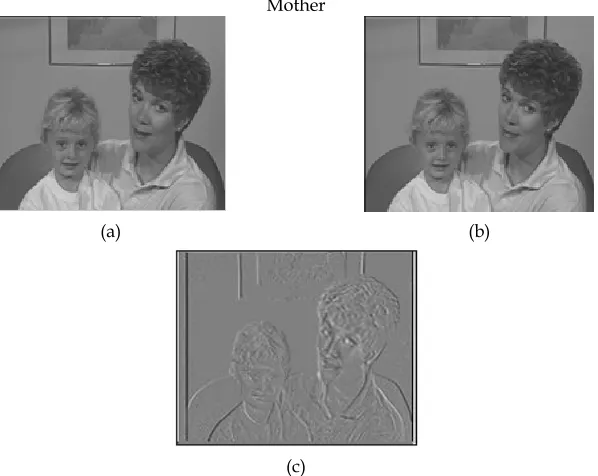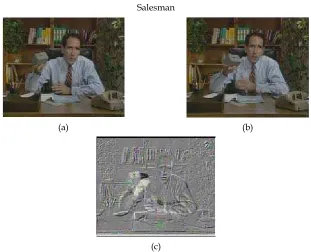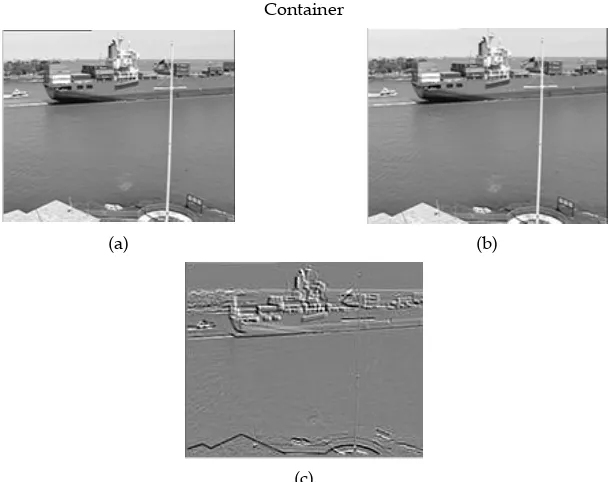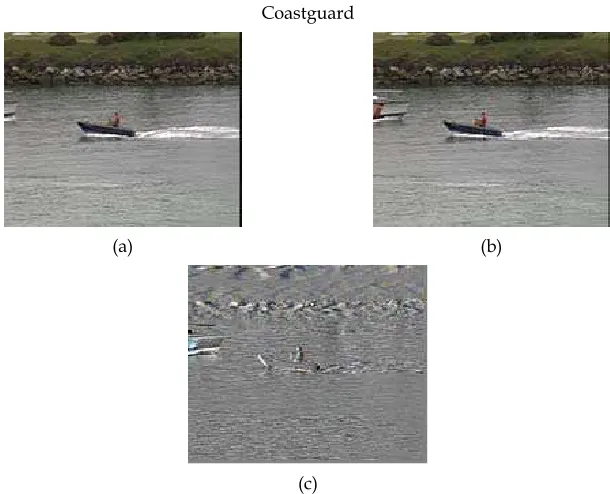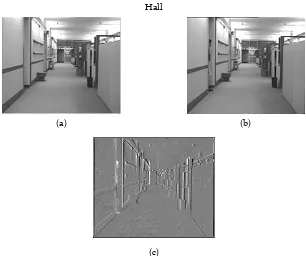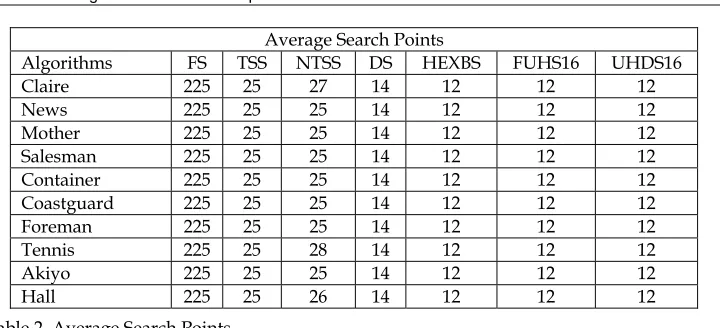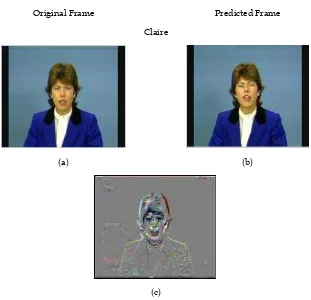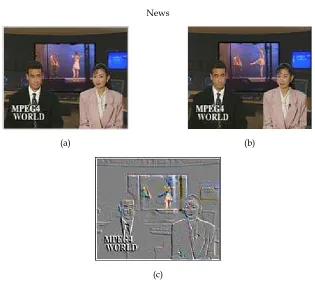Block Based Motion Vector Estimation
Using FUHS16, UHDS16 and
UHDS8 Algorithms for Video Sequence
S. S. S. Ranjit
Universiti Teknikal Malaysia Melaka (UTeM)
Malaysia
1. Introduction
1. Fast Unrestricted Hexagon Search (FUHS16) algorithm
In this section a short description about the Fast Unrestricted Hexagon Search (FUHS16) algorithm for motion estimation development based on some of the existing algorithms that have been discussed and simulated. Comparison of the performance among techniques is conducted as part of experimental result preparation.
FUHS16 algorithm is developed based on 16 × 16 pixels in a block size and two different models of hexagon sizes are applied to perform the motion vector search. Figure 1 shows how a single frame is extracted into required block size, where in FUHS16 algorithm each frame size is represented by 176 × 144 pixels. This means, that each frame will have 9 blocks horizontally and 11 blocks vertically. Hence, there are 99 extracted blocks in a video frame. Assumed has the following parameters i = horizontal (9 blocks),
j = vertical (11 blocks),
Eq. (1) shows the formula to extract the video frame into 16 × 16 block size.
B=CF(1+BZ*(i-1):BZ*i,1+BZ*(j-1):BZ*j) (1)
2. Fast unrestricted hexagon search algorithm search procedure
Fig. 1. Extraction 16 × 16 and 8 × 8 Pixels Block Size from Single Frame
These four checking points are compared in order to determine the final best-matched motion vector coordinate. Otherwise, the search continues around the point with the smallest MAD by using the same large hexagon search shape. This process continues till the large hexagon search shape moves along the direction of decreasing distortion. It is noted that a small hexagon search shape is applied in the final step after the decreasing distortion reaches optimum of the motion vector for large hexagon search shape. Then the small hexagon search shape will focus on the final search for the best-matched motion vector coordinate.
The proposed FUHS16 algorithm can be described further in the following three steps. i. Starting
The large hexagon search shape with seven checking points are centered at (+8, +8) and it is assumed as (0, 0). We name this as the predefined search window in the motion field. If the smallest MAD point with best-matched motion vector is found to be at the center of the large hexagon, we will proceed to Step (iii); otherwise Step (ii) will be proceed.
ii. Searching
Since the MAD point in the previous search step is not located at the center, a new large hexagon search shape is formed to perform new checking. It confines of seven checking points. Now the new MAD point is identified. If the MAD point is located at the center of newly to form large hexagon search shape, we proceed to Step (iii); otherwise, this step is repeated continuously till the next smallest MAD is again found at the center of large hexagon search shape.
iii. Ending
For the final search, large hexagon search shape determines the best-matched motion vector which is located at the center inner large hexagon search shape. After this, it will then switch to the small hexagon search shape to perform the final best-matched motion vector coordinate, MAD search point. The four points in the small hexagon search shape are evaluated to compare with the current MAD point. The MAD point is the final solution of best-matched motion vector coordinate location.
(
)
LHS = Large hexagon shape search points,
SHS = Small hexagon shape search points.
In Figure 2, the motion vector is predicted at MAD4 after emerging 3 hexagon search shape.
Based on the Equation 2, the
(
)
7 3(3) 4 20.x y
FUHS m m
N = + + = The FUHS16 needs 20 search points to predict final best-matched motion vector at MAD4.
MAD0 is the starting search point in the large hexagon search shape, center at coordinate
(+8, +8) – it is then assumed as coordinate (0, 0). The outer six points in the large hexagon search shape are evaluated to compare to the optimal MAD in the first search. If the optimal MAD is found to be at the center, then small hexagon search shape will take place to focus on the fine resolution search to predict the optimum motion vector in that area.
If the smallest MAD is found at one of the outer search point of large hexagon search shape, then three new search points are emerged to form a new large hexagon search shape as shows in Figure 2. The current optimal MAD is known as MAD1 and is positioned at the
center of newly form large hexagon search shape. The current coordinate of MAD1 is at (+7,
+10). All the points in the large hexagon search shape are again evaluated to predict the optimal MAD in the second search.
In the second search, the optimal MAD is MAD2 which is located at one the six outer search
points. Again three new search points are emerged to form a new large hexagon search shape and repositioned MAD2 to be at the center of newly formed large hexagon search
shape. The newly form large hexagon search shape is centered at coordinate (+6, +12). All the search points surrounding the large hexagon search shape are evaluated again to predict the optimal MAD.
In the third search, MAD3 is found at the outer search point of large hexagon search shape.
Three new search points are emerged to form a new large hexagon search shape and MAD3
is repositioned at the newly form large hexagons search shape. The new coordinate of MAD3 is (+7, +14).
All the points surrounding the MAD3 are evaluated again (assigned with number 2) and the
optimal MAD is located at MAD3 which is at the center of the large hexagon search shape.
Then the small hexagon search shape will take place surrounding MAD3 to conduct fine
resolution search at the inner search. All the four points in the small hexagon search shape are evaluated again to find the best-matched motion in that block. So, the MAD4 is the
optimal MAD found in the fine resolution search and is coordinated at (+8, +15).
The final coordinate is considered the best-matched motion vector coordinate in the block of the current frame. This process is repeated in every single frame to predict the best-matched motion estimation of a current frame.
MAD4
Initially center (8,8) – assume as at coordinate (0,0) - MAD0.
Fig. 2. Hexagon 3 new check points are formed and evaluated as new candidates to predict the motion vectors
3. Unrestricted Hexagon Diamond Search (UHDS16) algorithm
This section starts with some modifications from the FUHS16 algorithm. In this section, the UHDS16 technique is introduced. This technique is developed to have unrestricted search. To achieve this, a simple and efficient fast block-matching algorithm based on hexagon-diamond search shape is proposed. UHDS16 is designed uniquely with a large hexagon shape and shrink diamond search step (SDSS). Large hexagon is more unique to identify the motion vector in the small region of large hexagon shape. Finally, the shrink diamond search step is to locate the best-matched motion vector in the large hexagon small region. Experimental results show that the proposed UHDS16 algorithm significantly produces smaller computation complexity.
UHDS16 is designed to have repetitive search in the small region of large hexagon search shape. The large hexagon search shape is to locate the best motion vector before switching to shrink diamond search step for the final best-matched motion vector coordinate.
The UHDS algorithms are implemented using two different block sizes. Initially, the UHDS16 algorithm is developed using the 16 × 16 block size with search windows 15 × 15 and then the same technique and ideology is used for 8 × 8 block size with search windows size 7 × 7. The difference between UHDS16 algorithm and UHDS8 algorithm is the block size.
Figure 1 illustrates the extraction of 8 × 8 pixels block size from a single frame. The FUHS16 algorithm block extraction procedure is applied in the UHDS8 algorithm. This means, that each frame will have 18 blocks horizontally and 22 blocks vertically.
4. Unrestricted Hexagon Diamond Search (UHDS16) and (UHDS8) algorithm
search procedure
Based on the switching strategy with two different shape searches in Figure 3, we develop the following search methodology as depicted in Figure 4.
The UHDS algorithm employs two search procedures as depicted in Figure 3. Large hexagon is assigned with a signed number ‘1’. The hexagon shape procedure is to locate the final best-matched motion vector coordinate in the search area. The coarse hexagon shape continues to search till the motion vector found in the hexagon area is an optimal MAD point. This is then followed by the shrink diamond shape which checks all four points with number assigned with ‘2’ in Figure 3. The four search points are evaluated and compared to the center point in order to locate the final best-matched motion vector coordinate.
Figure 4 describes the basics of the UHDS16 and UHDS8 search algorithm. The number of search points needed for UHDS16 and UHDS8 algorithm is 12. The large hexagon is confined with seven outer search points, while the SDSS is confined with five search points.
Fig. 3. Hexagon-Diamond Search Modelling Shape
Fig. 4. Motion Estimation Search Procedure of Unrestricted Hexagon Diamond Search Algorithm
In the first step, seven checking points of the hexagon, within the search window around the motion vector predictor are compared to obtain the best motion vector. MAD is positioned at the center (0, 0) and served as a reference point to determine the final best motion vector in the SDSS. If the MAD point is found to be at the center of the hexagon search, then the hexagon search is switched to the small diamond search pattern for the final motion vector. In the second step, MADis the motion vector found by comparing the motion vector at step one MAD. If the MAD point is not located at the center and has best motion vector compared to the center one in step one, a new hexagon is formed and current MAD point
False
True
True
False
Step 1: Perform six points of hexagon shape, centered one point.
Optimal MAD at the center
Step 2: Continue large hexagon search for optimal MAD
Optimal MAD at the center
Step 3: The final four points covered by the small diamond are checked and the new optimal MAD point is the final solution for the motion vector.
becomes thecenter. All the six points surrounding MAD points will be compared again to relocate the best motion vector before switching to the small diamond search step.
In the third step, SDSS will finalize the best motion vector and make comparison to determine the greatest motion vector amongst the four MAD points. Otherwise, the second step is repeated until the best optimal MAD distortion and best motion vector are found.
5. Peak Signal-to-Noise Ratio
The PSNR is a method used for objective quality comparison between two values for different reconstructed images. It gives one measure of quality which is applied in image processing perspective. PSNR analysis uses a standard mathematical model to measure the difference between two images in video sequence. It is commonly used in the development and analysis of algorithms, and comparing image quality between different compression systems. The PSNR Equation (3) is mostly used as a measure of quality of reconstruction within the compression of images. The peak in PSNR refers to the maximum pixel value. The following formula is used to calculate the PSNR value:
10
The PSNR measured usually is in decibels (dB). The higher the PSNR, the better quality will be produced for a compressed or reconstructed image.
Where
Equation (4) describes the cumulative squared error between the compressed and the reference image. If the value of Equation (4) is low, then the squared error accumulated will be low.
5. Experimental result and discussion for FUHS16, UHDS16 and UHDS8
algorithm
This section describes about the experimental results for FUHS16, UHDS16, and UHDS8 algorithms. Each algorithm is conducted using ten different video sequences with size of 176 × 144 pixels. Each video sequence is represented with ten video frames for simulation purposes. The experimental results are measured using the MATLAB and described accordingly based on quality performance in terms of PSNR points, computational complexity in terms of search points and elapsed processing time for each algorithm.
5.1 Results for FUHS16 and UHDS16 algorithm
al., 2005), “News” – Slow Motion (Wu et al., 2010), “Mother” – Slow Motion (Yang et al., 2007), “Salesman” – Large Motion (Shilpa et al., 2010), “Container” - Slow Motion (Wu et al., 2010), “Coastguard” - Large Motion (Wu et al., 2010), “Foreman” – Medial Motion (Wang et al., 2010), “Table Tennis” – Large Motion (Chen et al., 2002), “Akiyo” – Slow Motion (Wang et al., 2008) and “Hall” – Slow Motion (Wu et al., 2010). Each of these video sequences have
Original Frame Predicted Frame Claire
(a) (b)
(c)
Fig. 5.1. (a) Claire Original Frame; (b) Claire Predicted Frame and (c) Claire Frame Difference
MV = 8, 8 MV = (9,5) (10,7)(8,6) Fig. 5.2. Search Points and PSNR Points for FUHS16 Algorithm (Claire)
News
(a) (b)
(c)
Fig. 5.4. (a) News Original Frame; (b) News Predicted Frame and (c) News Frame Difference
MV = (8,8) MV = (10,6)(10,7)(9,7) Fig. 5.5. Search Points and PSNR Points for FUHS16 Algorithm (News)
Mother
(a) (b)
(c)
Fig. 5.7. (a) Mother Original Frame; (b) Mother Predicted Frame and (c) Mother Frame Difference
MV = (8,8) MV = (8,6)(10,7)(7,7) Fig. 5.8. Search Points and PSNR Points for FUHS16 Algorithm (Mother)
Salesman
(a) (b)
(c)
Fig. 5.10. (a) Salesman Original Frame; (b) Salesman Predicted Frame and (c) Salesman Frame Difference
MV = (8,8) MV =(9,5) (10,7) (8,6) Fig. 5.11. Search Points and PSNR Points for FUHS16 Algorithm (Salesman)
Container
(a) (b)
(c)
Fig. 5.13. (a) Container Original Frame; (b) Container Predicted Frame and (c) Container Frame Difference
MV = (8,8) MV = (9,6) (10,7) (8,7) Fig. 5.14. Search Points and PSNR Points for FUHS16 Algorithm (Container)
Coastguard
(a) (b)
(c)
Fig. 5.16. (a) Coastguard Original Frame; (b) Coastguard Predicted Frame and (c) Coastguard Frame Difference
MV = (8,8) MV = (9,5)(10,7)(8,6) Fig. 5.17. Search Points and PSNR Points for FUHS16 Algorithm (Coastguard)
Foreman
(a) (b)
(c)
Fig. 5.19. (a) Foreman Original Frame; (b) Foreman Predicted Frame and (c) Foreman Frame Difference
MV = (8,8) MV= (8,6) (10,7) (7,7) Fig. 5.20. Search Points and PSNR Points for FUHS16 Algorithm (Foreman)
Table Tennis
(a) (b)
(c)
Fig. 5.22. (a) Table Tennis Original Frame; (b) Table Tennis Predicted Frame and (c) Table Tennis Frame Difference
MV = (8,8) MV = (10,7) (10,7) (9,8) Fig. 5.23. Search Points and PSNR Points for FUHS16 Algorithm (Table Tennis)
Akiyo
(a) (b)
(c)
Fig. 5.25. (a) Akiyo Original Frame; (b) Akiyo Predicted Frame and (c) Akiyo Frame Difference
MV = (8,8) MV = (9,6) (10,7) (8,7) Fig. 5.26. Search Points and PSNR Points for FUHS16 Algorithm (Akiyo)
Hall
(a) (b)
(c)
Fig. 5.28. (a) Hall Original Frame; (b) Hall Predicted Frame and (c) Hall Frame Difference
MV = (8,8) MV = (9,6) (10,7) (8,7) Fig. 5.29. Search Points and PSNR Points for FUHS16 Algorithm (Hall)
300 raw video frames, the video format of Quarter Common Intermediate Format (QCIF) and can be categories into different motion varying from small to large. Based on the presented results, original frame and predicted frame is not similar to the matched frame. This is to reveal that there is object translation between the original frame and predicted frame.
The motion vector coordinates shown are for ten video frames that have been conducted in FUHS16 and UHDS16 algorithm. Based on each vector coordinate, the motion represents the object translation between two frames. The first coordinate shows the first search of large hexagon shape, second vector coordinate represents the repetitive search of large hexagon shape and the best-matched motion vector coordinate represent the search for small hexagon shape. The repetitive search of large hexagon search is to gauge for the best-matched zero motion in the large hexagon region. While the small hexagon shape will finalized the best-matched motion vector coordinate among the four search points in the small region.
The results shown in Table 1 are the average PSNR points for FS, NTSS, TSS, DS, HEXBS, FUHS16 and UHDS16 algorithms. The average PSNR points values for all ten video sequences. These results are used for analysis purposes and for further improvement.
Average PSNR Points (dB)
Algorithms FS TSS NTSS DS HEXBS FUHS16 UHDS16 Claire 39.93 38.91 38.91 39.04 39.20 39.23 39.89 News 37.65 36.95 37.26 37.34 37.35 37.21 37.57 Mother 43.21 42.70 42.70 42.79 42.75 42.70 42.92 Salesman 37.20 36.40 36.55 36.74 36.66 36.57 37.07 Container 40.02 40.02 40.02 40.02 40.02 40.02 40.02 Coastguard 33.11 31.00 31.03 31.09 31.03 31.00 33.11 Foreman 26.40 24.25 24.78 24.46 25.76 25.74 26.28 Tennis 32.47 26.39 28.00 27.52 28.95 29.26 29.07 Akiyo 47.06 47.06 47.06 47.06 47.05 47.05 47.06 Hall 40.30 40.29 40.30 40.30 40.29 40.29 40.30 Table 1. Average PSNR Points
Based on the average PSNR points, FUHS16 and UHDS16 algorithms produces similar PSNR points compared with the other algorithms. However, UHDS16 algorithm shows significant improvement in measuring the average PSNR point’s compares with FUHS16 algorithm.
UHDS16 algorithm has outperformed all the other algorithms except for the FS algorithm in terms of PSNR point measurement. The overall average PSNR point’s difference between UHDS16 and FS algorithm is approximately 0.31 dB. The importance to calculate the overall average PSNR points is to show the individual comparison of each algorithm.
Average Search Points Table 2. Average Search Points
a search points (52 percent) and NTSS requires 16 extra search points (57.1 percent) to gauge the similar motion vector coordinate as FUHS16 algorithm and UHDS16 algorithm.
Based on average PSNR points and average search points, FUHS16 algorithm and UHDS16 algorithm maintains the similar PSNR point’s quality even though the search points are reduced 94.7 percent compare with FS algorithm. This also shows that reducing the search points can still maintain the similar performance and quality compare with the other algorithms. And, reducing the search points also reduces the computational complexity in terms of the MAD calculation (search points) and increases the best-matched motion vector coordinate estimation performances.
Table 3 shows the average elapsed processing time taken for FS, TSS, NTSS, DS, HEXBS, FUHS16 and UHDS16 algorithms. Based on the presented result, UHDS16 algorithm has the lowest average elapsed processing time compared with all the other algorithms. FUHS16 algorithm saved a small relative average elapsed processing time compared with HEXBS algorithm and DS algorithm. UHDS16 algorithm and FUHS16 algorithm approximately saved 14 percent, 23 percent and 55 percent of average elapsed processing time compared with NTSS, TSS and FS algorithms respectively. The result for UHDS16 algorithm shows, even though the search points are reduced and repetitive search pattern is developed, the average elapsed processing time still can be reduced.
Average Elapsed Processing Time (Sec)
5.2 Results for UHDS8 Algorithm
In order to evaluate the performance of UHDS8 algorithm, the UHDS8 algorithm is compared with the FS, TSS, NTSS, DS, and HEXBS algorithms in terms of the average PSNR points, computation complexity in terms of average search points and average elapsed processing time.
Original Frame Predicted Frame Claire
(a) (b)
(c)
Fig. 5.31. (a) Claire Original Frame; (b) Claire Predicted Frame and (c) Claire Frame Difference
News
(a) (b)
(c)
Fig. 5.33. (a) News Original Frame; (b) News Predicted Frame and (c) News Frame Difference
MV = (4,4) MV = (5,2) (5,2) (2,4)
Mother
(a) (b)
(c)
Fig. 5.35. (a) Mother Original Frame; (b) Mother Predicted Frame and (c) Mother Frame Difference
MV = (4,4) MV = (4,2) (3,2) (3,3)
Salesman
(a) (b)
(c)
Fig. 5.37. (a) Salesman Original Frame; (b) Salesman Predicted Frame and (c) Salesman Frame Difference
MV = (4,4) MV = (5,2) (5,2) (2,4)
Container
(a) (b)
(c)
Fig. 5.39. (a) Container Original Frame; (b) Container Predicted Frame and (c) Container Frame Difference
MV = (4,4) MV = (5,2) (5,3) (4,3)
Coastguard
(a) (b)
(c)
Fig. 5.41. (a) Coastguard Original Frame; (b) Coastguard Predicted Frame and (c) Coastguard Frame Difference
MV = (4,4) MV = (5,2) (6,4) (4,3)
Foreman
(a) (b)
(c)
Fig. 5.43. (a) Foreman Original Frame; (b) Foreman Predicted Frame and (c) Foreman Frame Difference
MV = (4,4) MV= (4,3) (5,-5) (3,4)
Table Tennis
(a) (b)
(c)
Fig. 5.45. (a) Table Tennis Original Frame; (b) Table Tennis Predicted Frame and (c) Table Tennis Frame Difference
MV = (4,4) MV = (5,2) (5,2) (2,4)
Akiyo
(a) (b)
(c)
Fig. 5.47. (a) Akiyo Original Frame; (b) Akiyo Predicted Frame and (c) Akiyo Frame Difference
MV = (4,4) MV = (5,2) (6,4) (3,6)
Hall
(a) (b)
(c)
Fig. 5.49. (a) Hall Original Frame; (b) Hall Predicted Frame and (c) Hall Frame Difference
MV = (4,4) MV = (4,2) (5,4) (4,3)
In this section, the proposed UHDS8 algorithm is compared with the popular FS, NTSS, TSS, DS, HEXBS and FUHS8 algorithms. In the first stage, ten video frames from each video sequence are used to simulate the coded algorithm. The results using UHDS8 algorithm and all the other algorithms are shown in Table 4 for average PSNR points, Table 5 for average search points and Table 6 for average elapsed processing time.
Average PSNR Point (dB)
Algorithms FS NTSS TSS DS HEXBS UHDS8 Claire 40.46 38.91 38.91 39.47 39.48 39.76 News 38.47 37.46 36.95 37.69 37.72 37.73 Mother 43.88 42.72 42.69 42.89 43.22 43.29 Salesman 38.11 36.83 36.40 36.80 36.82 37.48 Container 40.03 40.02 40.02 40.02 40.02 40.03 Coastguard 33.95 31.16 30.10 31.16 32.98 33.94 Foreman 28.40 25.06 24.25 25.01 27.65 27.96 Tennis 32.64 27.10 26.40 28. 60 29.05 29.15 Akiyo 47.48 47.06 47.06 47.25 47.28 47.42 Hall 40.45 40.34 40.29 40.30 40.31 40.31
Table 4. Average PSNR Points
Table 4 shows the average PSNR points for FS, TSS, NTSS, DS, HEXBS, FUHS8 and UHDS8 algorithms. The FS algorithm has the most promising result among all the developed algorithms. This is because FS algorithm does brute search among all the search points. In Table 5.4, the average PSNR points shows that the UHDS8 algorithm improves the average PSNR points compared with the NTSS, TSS, DS, HEXBS, and FUHS8 algorithms. Analysis shows “Claire” video sequence have improved 0.13 dB of average PSNR point’s compared with HEXBS algorithm and DS algorithm. While, “Coastguard” have improved approximately 3 dB of average PSNR point’s compared with TSS, NTSS and DS algorithms. “Akiyo” and “Container” video sequences produces the similar average PSNR point’s compared with all the other algorithms. The average PSNR points for “Salesman” and “Tennis” video sequences also improved approximately to 0.55 dB compared with all the other algorithms. This shows that UHDS8 algorithm can also produce similar average PSNR points compared with FS algorithm while locating the best-matched motion vector coordinate.
Referring to the Table 5, FUHS8, UHDS8 and HEXBS algorithms have the lowest average search points compared with all the other algorithms. FS and TSS algorithms have 49 and 25 fixed search points respectively. Meanwhile NTSS algorithm search point ranging from 25 to 33 and DS algorithm has 14 search points.
Based on the average search points obtained from Table 5, FS algorithm needs to perform extra numbers of MAD calculations in order to determine the optimal MAD point. This will lead to extra usage of memory and consume 52 percent of extra processing time to predict the similar image as UHDS8 algorithm. UHDS8 algorithm reduces search points and elapsed processing time to perform all the MAD calculations in order to estimate the MAD point.
Hence, this shows that UHDS8 algorithm have the ability to reduce the elapsed processing time while maintaining the global optimal point properties of the image. Besides that, the UHDS8 algorithm approximately can save up to 37 search points compared with FS algorithm, 2 search points compared with DS algorithm, 13 search points compared with TSS algorithm and 21 search points compared with NTSS algorithm. This shows that the UHDS8 algorithm requires less MAD calculation and save memory approximately up to 75.5 percent compared with all the other algorithms.
Table 6 shows the elapsed processing time compared with FS algorithm. UHDS8 algorithm has the lowest average elapsed processing time compared with TSS, NTSS, DS, and HEXBS algorithms. Thus, Table 6 reveals that UHDS8 algorithm approximately has saved 40 percent of processing time compared with FS algorithm. Meanwhile, TSS, NTSS, DS and HEXBS algorithms approximately saved 21 percent, 19 percent and 29 percent average elapsed processing time respectively.
Average search points
Algorithms FS TSS NTSS DS HEXBS UHDS8 Claire 49 25 26.99 14.70 12 12
Table 5. Average Search Points
average elapsed processing time produced by UHDS8 algorithm is almost similar as FUHS8 algorithm, but UHDS8 algorithm average elapsed processing time is slightly faster. UHDS8 algorithm approximately saved 3 percent of average elapsed processing time compared with UHDS8 algorithm. TSS algorithm and NTSS algorithm shows increment of 14 percent and 18 percent average elapsed processing time respectively.
Average Elapsed Processing Time (Sec)
Algorithms FS TSS NTSS DS HEXBS UHDS8 Claire 2.84 1.86 1.65 1.53 1.34 1.21
Table 6. Average Elapsed Processing Time
6. Conclusion
Motion vector estimation is the processes which generates the motion vectors to determine how each motion compensated prediction frame is created from the previous frame. Motion estimation is basically extracting the difference between the reference frame compared with the current frame. Motion vectors are typically used to compress the frame by storing the changes in the current frame. The vectors are used to detect and track the motion and to find the information required in the current frame. In this thesis, the previously developed algorithms were investigated and new algorithms were to design to compare the performance with the discussed algorithms.
Five most widely known motion estimation algorithms such as the full search, three step search, new three step search, diamond search and hexagon based search algorithms were explicated. All of these algorithms are reported to be the baseline algorithms in block-matching motion estimation algorithm development. These algorithms are studied to understand the basis of block-matching motion estimation. The motion vector is determined using the motion estimation block prediction. The knowledge is used to develop the proposed algorithm.
slow to fast. All the discussed algorithms are simulated using all the different type’s video motion. The purpose of testing each algorithm with different kind of motions is to test the algorithms robustness. This also will explain that each algorithm is suitable to perform motion vector estimation based on different type of motions.
Based on this research and the findings of this study with baseline models, FUHS16 algorithm is selected as the basic algorithm for the proposed algorithm. Other proposed algorithms are used for comparison with all the superior algorithms. Fewer search points, less computational complexity and time savings was consequently proposed.
Validation of results involved three categories which are image PSNR points, computational complexity in terms of search points and elapsed processing time. In this thesis, the proposed algorithms are developed to have similar result as FS algorithm while out performing the other TSS, NTSS, DS and HEXBS algorithms. Additionally, measuring the PSNR points of each proposed algorithm is to determine the efficiency of the proposed algorithm. Based on the accumulated results, the proposed algorithms which are FUHS16, FUHS8, UHDS16 and UHDS8 have improved the search point efficiency and effectively have saved the elapsed processing time. This leads to lesser computational complexity when motion estimation prediction is done.
The proposed algorithm shows favorable characteristics for use in a real-world system. The PSNR point’s measurements are similar or equal to that achieved using FS algorithm motion estimation block. Furthermore, the PSNR points measurement achieved by the proposed algorithm has outperformed the TSS, NTSS, DS and HEXBS algorithms. As in section 5.2, the UHDS8 algorithm has very close PSNR points measurement as compared with FS algorithm. Besides that, UHDS8 algorithm has also saved 94.7 percent of the computational complexity in terms of search points. The UHDS8 algorithm has also saved approximately 57 percent of the elapsed processing time to estimate the best-matched block compared with the FS algorithm. The numbers of memory accesses required during operation were also reduced.
7. References
Chen, M. J., Chu, M. C., and Pan, C. W. (2002). Efficient motion-estimation algorithm for reduced frame-rate. IEEE Transactions on Circuit and Systems for Video Technology, 12(4), 269 – 275.
Lee, J. K. & Chung, K. D. (2005). Conversion Scheme DCT-Domain Transcoding of MPEG-2 to H.264/AVC. International conference on image analysis and processing, pp. 551-558, 3617, Italy, September, 2005, Springerlink, Cagliari.
Shilpa, P. M. & Sanjay, N. T. (2010). Fast Motion Estimation Using Modified Orthogonal Search Algorithm for Video Compression. Journal of Signal, Image and Video Processing, 4(1), 123-128.
Wang, P., Zheng, Z. & Li L. (2008). A video watermarking scheme based on motion vectors and mode selection. International Conference on Computer Science and Software Engineering, 5, 233-237.
